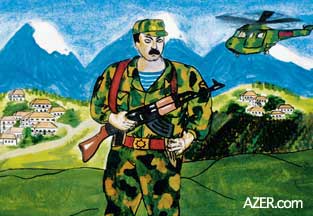|

Winter 2002 (10.4)
Pages
44-45
Perceptions of War
Children's
Art Depicts a Society in Deep Grief
by Anne Kressler
Posters: Clockwise from above left: Nigar Aliyeva
9; Sasha Morohov 9; Nigar Shamsiyeva 7; Aysel Jahangirov 13.
If children's art provides
insight into the psychology of a nation in the midst of war,
then Azerbaijan can be said to be experiencing deep stages of
grief - at least, that's the obvious message in an exhibit entitled
"Children's Perceptions of War" at the Children's Art
Gallery in Baku (28th of May Street) [under the direction of
Art Director Katana Sharifova].
  Left: Art by Dima Vidrin, 13 Left: Art by Dima Vidrin, 13
The majority of works,
painted in watercolor, focus on the loneliness, pain, uncertainty
and fear of this horrible thing called war, which has battered
and scarred Azerbaijanis and Armenians for the past six years.
Generally speaking, the paintings are best characterized by their
sadness and great sense of loss, not by anger or revenge.
Studied collectively, they provide considerable insight into
the prevailing attitudes about the war, especially in terms of
what is not represented in the paintings. For example, the usual
glamour, romanticism and adventure associated with war is missing.
Battle scenes are depicted against the backdrop of mountain villages
and show a strong sense of realism. The children's choices of
muted colors are meaningful, too. Perhaps art supplies were limited,
but then again, it may have been the oppressiveness of war that
has caused them to choose somber browns, blues and greens more
frequently than dramatic reds.
  Left: Rustam Guliyev, 6 Left: Rustam Guliyev, 6
Demonization of the enemy is extremely rare in this exhibition.
Armenians are not depicted as monsters, except in the isolated
cases of one or two children who are only six years old, and
even then, the images are more frightful than hateful. (One sketch
looks more like a centipede from outer space than any kind of
identifiable earth creature.)
Demonization is a powerful tool that is often used to energize
war efforts. Take, for example, the United States' initiation
into the Gulf War a few years ago [1990]. Before the attacks
were made, a conscious effort was made to win U.S. public support
against Iraqi leader Saddam Hussein. He was often depicted as
monstrous, villainous and primitive. Insinuations were often
made about camels - implying backwardness. [Former] President
Bush referred to him as Hitler, attempting to bridge the connection
from the unknown (since most Americans had little knowledge about
Saddam Hussein prior to the war) to something unquestionably
evil in most people's minds. An entire series of "Saddam
Hussein jokes" spread through the whole society, fanned
by television, print media and political cartoonists. But in
Azerbaijan, which has had ample time for deep hatreds to become
entrenched, even among children, such demonization is clearly
absent.
  Art: Turkan Gurbanov, 10 Art: Turkan Gurbanov, 10
For Azerbaijanis, this war is particularly painful since many
people used to share deep friendships with Armenians. "We
used to be friends," they'll tell you in their efforts to
describe this great tragedy. In the past, intermarriages were
quite frequent.
Paolo Lembo, United Nations Development Program (UNDP) Representative,
who has been living in Baku for the last two years, recently
observed, "Azerbaijanis are very mild by nature. You rarely
hear anyone speaking aggressively against Armenians. It's very
strange. In other countries where I've worked under similar circumstances,
there's an immense hatred that permeates the entire society.
You feel it everywhere. But not in Azerbaijan. It's as if the
people are in a state of shock and disbelief that this war could
have even happened. It doesn't make sense to them. Azerbaijanis
are very gentle. It signifies that they are ready to meld with
different cultures, different trading cultures and different
contexts."
It would seem that these children's paintings confirm Lembo's
impressions - that the people making the deepest impressions
on these youth are not characteristically vengeful or driven
by hate.
___
Back to Index
AI 10.4 (Winter 2002)
AI Home
| Search | Magazine
Choice
| Topics
| AI Store | Contact us
Other Web sites
created by Azerbaijan International
AZgallery.org | AZERI.org | HAJIBEYOV.com
|